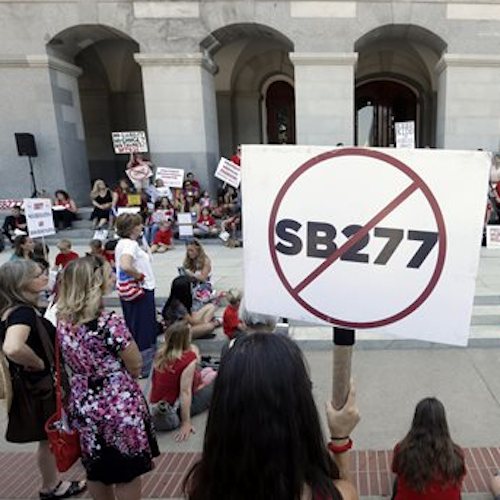Rebecca Estepp was among those protesting outside the California state capitol last week when Gov. Jerry Brown signed a law that restricts who can be exempted from school vaccinations. Estepp believes that vaccines led to her son’s autism, and there’s no questioning her grief, nor the fervor of those challenging the new law. But it can be problematic when news outlets accept without question the assertions of protesters like Estepp.
Here’s how The Los Angeles Times referred to her: “Estepp, who said her 17-year-old son was injured by a vaccine, said opponents would be likely to challenge the law in court.” An article on nbcbayarea.com went further into Estepp’s family story: “Her 17-year-old son, Eric, was vaccinated when he was young. His mother says vaccines caused his brain to swell and then he developed autism. ‘Most families are like mine,’ Estepp said. ‘We didn’t know we had a problem, a genetic susceptibility to vaccine injury, until it was too late. So this law is going to put families like mine with genetic susceptibility at risk for more children to be harmed just like my son was.’”
NBC failed to mention that Estepp is communications director for the anti-vaccine non-profit Health Choice. The Times said she “belongs to the advocacy group California Coalition for Health Choice,” her secondary spokesperson role. Neither outlet sought to distinguish the facts (that Estepp’s son was vulnerable because of an immune deficiency) from the fiction (that the vaccine can cause autism).
Four years earlier, a news service in San Diego, near where Estepp lives, published a piece about a new study discrediting the link between vaccination and autism, yet Estepp told the San Diego reporter that she “rolled her eyes” upon hearing that.
These days, however, in her frequent public appearances, Estepp says she’s more nuanced about the autism link, but that doesn’t always make it into print. “I’ll see reporters write, ‘Rebecca Estepp says a vaccination gave her son autism,’ but it’s not that simple,” she told CJR. As she tells it, a vaccine injury set off a chain of ailments that led to autistic behavior. It’s not a simple cause-and-effect, even in her mind.
It’s unreasonable to expect reporters on deadline to dig into the medical history of every protester they quote. And there is value in explaining the underpinnings of political passion, even if that passion is born from misinformation. But it’s also the media’s role to distinguish between ordinary people in a crowd and professionals who show up at such events while also having an official capacity with a political group. More importantly, the testimonials of individuals should be accompanied by an authoritative explanation of scientific research. Without it, reporters seeking to describe dissent are more likely to spread confusion.
“It’s definitely a balancing act because you want to articulate both sides of the debate without getting a lot of misinformation out,” explained Shelby Grad, The Times assistant managing editor overseeing California coverage. The protesters in Sacramento were worth hearing, he said, especially since his newspaper has done in-depth reporting on the necessity of vaccinations before.
When hard science is involved, striving for “balance” can be counter-productive. Fair reporting gives equal treatment to an ideological divide, but not equal weight to both sides of a factual misunderstanding. Journalistic equivocating in such cases doesn’t reinforce objectivity. It only serves to muddle.
“The trick, of course, is to determine those facts, to identify the established truth,” New York Times Public Editor Margaret Sullivan wrote. “Editors and reporters say that is not always such an easy call. And sometimes readers who demand ‘just the facts’ are really demanding their version of the facts.” Indeed, for something like economic policy, truth may be a matter of perspective. For evolution, climate change, or vaccines, it’s a news reporter’s job — not just a columnist’s — to help settle debate.
“There are compact ways to acknowledge consensus and signal to readers that the facts are clear,” said Brendan Nyhan, a Dartmouth professor who has written extensively about managing misinformation in news stories. As a good example, Nyhan cited The New York Times coverage of the pope’s environmental advocacy: “Francis reiterated the established science that burning fossil fuels are warming the planet.”
The Sacramento Bee’s reporting on Gov. Brown’s bill signing did not offer a firm statement about vaccination safety. The article quoted one of the protestors, Kimberly McCauley, as did the Associated Press. According to the Bee: “McCaulley carried pictures of her 2-year-old daughter Ella, whom she said she stopped vaccinating after Ella had adverse reactions to three immunizations, and a letter from her pediatrician denying Ella a medical exemption. ‘My daughter is the sweetest little girl, and every day she asks when she gets to go to school,’ McCauley said, choking back more tears. ‘She doesn’t deserve to be discriminated against.’”
Jeremy B. White, one of the Bee reporters on that story, said “it gets really tricky” whether to take these sources at their word, especially on a tight deadline. For the narrow purpose of explaining McCauley’s political feelings, White considered that phrasing acceptable. But what medical conditions does Ella have? Would a proper reading of the law grant her a vaccine exemption? Is the doctor’s letter the final word? And what good is that word to a reader without context? The more substantive the anecdote, the more it demands further reporting.
Estepp says she often hears from reporters who want her family’s story but only have a couple minutes to talk. If the topic is too complex and contentious, and there isn’t time to fact check, there’s nothing gained by giving the short version a shot.
Danny Funt is a senior editor at The Week and a former CJR Delacorte Fellow. Follow him on Twitter at @dannyfunt

